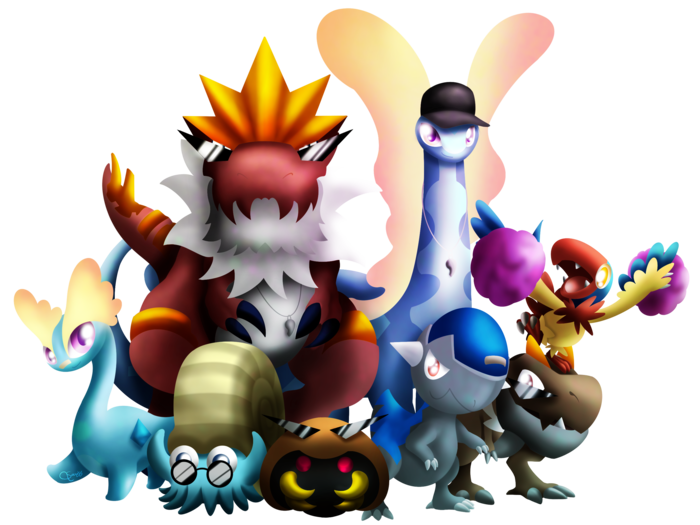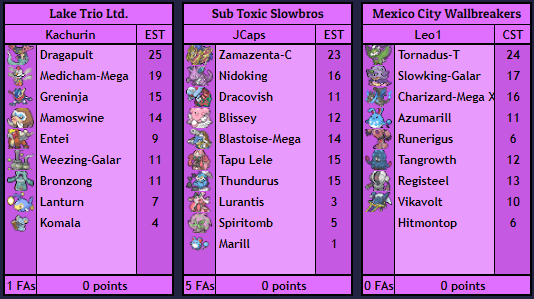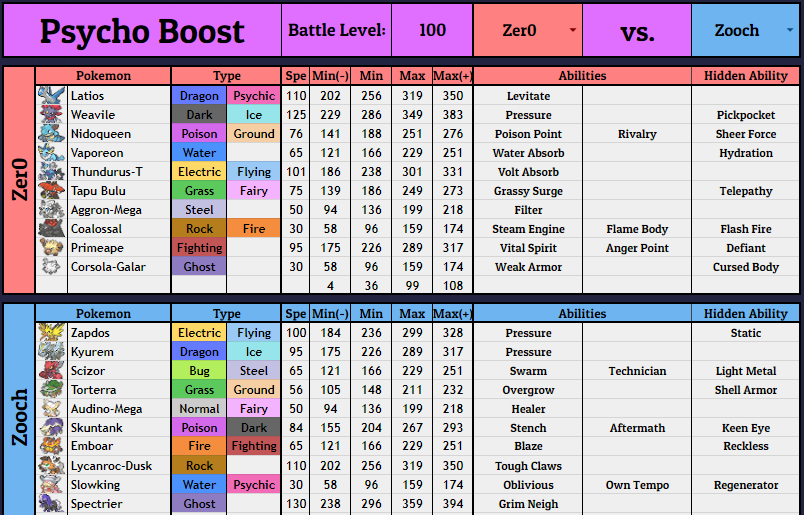Beginner's Guide to Draft League
| « Previous Article | Next Article » |

Art by Swiffix.
Table of Contents
Why Play Draft League?
A draft league is where individuals (coaches) take turns drafting teams of unique Pokémon and battling each other weekly until one coach is crowned the Champion. They do this by analyzing how their 8-12 Pokémon match up against their opponents' and then bringing the best six of their draft to counter their opponent's draft. Many servers center their identity and niche around the members of their community and those members' connections to the draft league community as a whole. Whether your desire is to be the best draft league coach on the scene, try out any number of custom metas, or experience what it's like to run your own community, the draft league community will grant your wish and more. Being able to realize nostalgic interest in Pokémon with a group of friends across the globe, sharing and creating new memories together, is an amazing thing. Any acronym you may see mentioned in this article may be found at the very bottom under the category titled "VI. Legend".
Server Types and Formats
Nearly all Discord-based draft leagues use Google Sheets to track everything from standings to roster information, rules, and more. There are also leagues that use alternate methods such as websites. This guide will focus on leagues that use Google Sheets, as they are far more common. There are a few major types of servers in the community that revolve around different draft league formats:
Standard League
Seasons are 7-11 weeks in length, followed by playoffs in which the top half of coaches compete. They contain anywhere from 8-24 coaches who draft rosters of 8-12 Pokémon and face off weekly. Some leagues will have more than one division (group of 8-24 coaches), which are generally sorted by skill, leading to promotions and demotions between seasons based off performance in the previous season, with newer and lesser-known players starting in the lower divisions. Example: WPF, DGBA, TH
Other formats exist as well, such as (but not limited to) LC, 4v4 Doubles (VGC style), multi-generation, Ubers, AAA, and fan-made formats such as Insurgence and Radical Red. Example: APA LC, WBG, BBL, HBF
Team Tournament
Two components separate team tournaments from standard leagues: you draft players as well as Pokémon teams, and weekly series are best of 7 matches rather than best of one (but each player will still only play one game). All team captains (managers) will participate in an auction where they take turns nominating, then bidding on coaches to add to their team (8-12 coaches total). Each tour generally consists of 3-4 formats, with each team having 3-4 drafts per format (there will always be one more draft per format than there are games per week for it). Each week, the teams will select which drafts to play, leaving one draft on the bench in each format. Teams may make changes to their coach roster or their drafts during a midseason week (typically after week three). At the end of each week, whichever team has the most wins out of seven is who wins the week, there are no week ties. Playoffs generally feature the top half of teams in a single elimination bracket. Example: DPL, TDT, CoK, PW
Singles Tournament
Traditionally played for cash prizes, these "tours" accommodate however many coaches sign up in increments of 8-16. Coaches draft a team of 8-10 Pokémon within a draft pool of 8-16 coaches and are placed into round robin "battle pools" with three other coaches. The two coaches with the best records will progress out of pools into a bracket, which can be single or double elimination. Example: THT, SPSO
Just like standard leagues, other formats also have tours, such as LC, 4v4 Doubles (VGC style), and Ubers. Example: APA LCL, BBT
Rulesets and Drafting
Most leagues you'll encounter will be standard singles, with largely similar rulesets, but it is always worth checking the league-specific sheet and asking league staff for specific rules. Below is an example ruleset from WPF.
Drafting Rules
Complex bans such as no Seismic Toss on Mega Kangaskhan, no Protean on Greninja, and no Power Construct on either Zygarde forme are commonplace and are denoted by cell notes on the Pokémon on the draft board. There are two major tiering systems: points (the more commonly used one that will be the standard on Smogon) and tiers (a more dated format that is based upon draft's roots). Points splits Pokémon into 18-20 different value-based groups, with Mega Evolutions included, whereas tiers splits them into 5-10 tiers and separates Mega Evolutions into their own categories. See screenshots below for examples from WPF.


Season Rules
"F/A" or free agent transactions simply involve dropping one Pokémon on your team for another. They are counted based off the number of Pokémon you pick up, and the number of these varies from league to league. You are required to never exceed your point limit regardless of how your trades work.

Battle Rules
Some rules that may differ from league to league are whether or not cut moves are included (e.g. Hidden Power, Return), timer rules (whether or not it can be turned on at all by either coach in game), and others. Drafting is done from one draft board, i.e. you cannot have one Pokémon drafted more than once in each pool of coaches. Once a Pokémon gets drafted by someone else, you can no longer draft it, which adds the skill of being able to plan ahead and adapt to "snipes" as they occur.

Examplers of finalized rosters

Teambuilding and Drafting
The premise behind draft league matches is simple: conceptualize and design six Pokémon from your full team to beat every variation of your opponent’s team of 8-12 Pokémon. Both coaches' drafts are publicly available throughout the season, so the game becomes about outsmarting your opponent in innovative ways to catch them off guard and leave them with no answers for your Pokémon. Example of a "MU" or matchup:

See how the game turned out here: https://replay.pokemonshowdown.com/sports-gen8nationaldexdraft-746981
Zooch chose to bench his Mega Audino, which meant his defensive answers to Weavile and Latios looked lacking. This became evident when Zooch was forced to sacrifice Scizor, the primary Weavile check, against Calm Mind Latios . Repeated Shadow Ball Special Defense drops on Nidoqueen nearly spelled disaster for Zer0, but he was able to capitalize on trading down pieces and forcing Zooch to incur enough Stealth Rock damage to ultimately win the attrition game.
Final Thoughts
There are multiple cornerstone leagues that feed into each other and the larger community. I will mention some of them below; not all are beginner level, yet all are fantastic leagues to aspire to be a part of. I hope this guide was concise and helpful, and please don’t be afraid to reach out to me in DMs if you have questions or if anything in this guide was unclear. Welcome to Draft League!
- WPF: https://discord.gg/AT45uytqQU
- DGBA: https://discord.gg/dgba
- EDC: https://discord.gg/wbxUHzhahm
- DPL: https://discord.gg/kGW3ZqCp49
Legend (in order of appearance)
- WPF - World Pokémon Federation, the largest public server draft league, commissioned by Rissoux#0001.
- DGBA - Discord Global Battle Association, the most competitive public server draft league, commissioned by Aggronauts#0093 & Brandon | LKRMoose17#2958.
- TH - Trick House, one of the most competitive private server draft leagues, commissioned by Bagel John#6666.
- APA LC(L) - American Pokémon Association Little Cup (Legends), the largest public server Little Cup draft league/tournament, commissioned by TRowePrice#3387.
- WBG - Wigglytuff’s Battle Guild, a large, public server 4v4 Doubles draft league, commissioned by Hopeless#5089.
- BBL/T - Banlist Battlers League/Tournament, the largest, public server, Ubers draft league/tournament, commissioned by OliviaCMM#7262.
- HBF - Holon Battle Frontier, the hub league for draft leagues using Pokémon from the fangame Pokémon Insurgence, commissioned by Eggshmimpt219#6431..
- DPL - Draft Premier League, the largest and most competitive team tournament, commissioned by King L5#3533.
- TDT, CoK, and PWS - Team Draft Tournament, Clash of Kings, and Pokémon World Series, the 3 other major team tournaments in the draft league calendar, commissioned by Undead#0041, TRowePrice#3387, and Hacker respectively.
- THT and SPSO - Trick House Tournament and Sky Pillar Stadium Open, the largest singles tournaments in draft, commissioned by Bagel John#6666 and SunSun#7096 respectively.
- EDC - Everyone Draft Community, a large community draft league, a great place for new players, commissioned by Burning.
| « Previous Article | Next Article » |